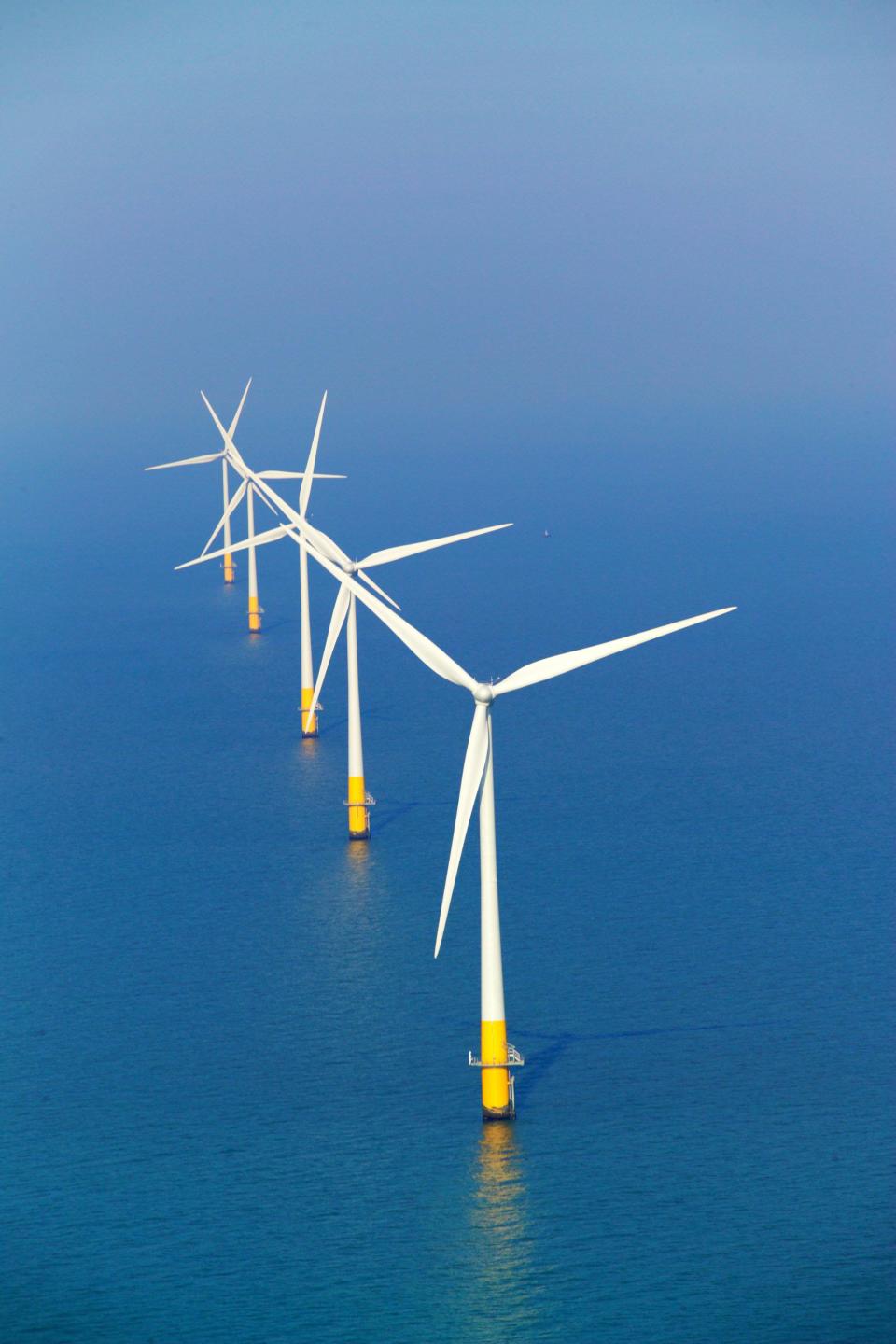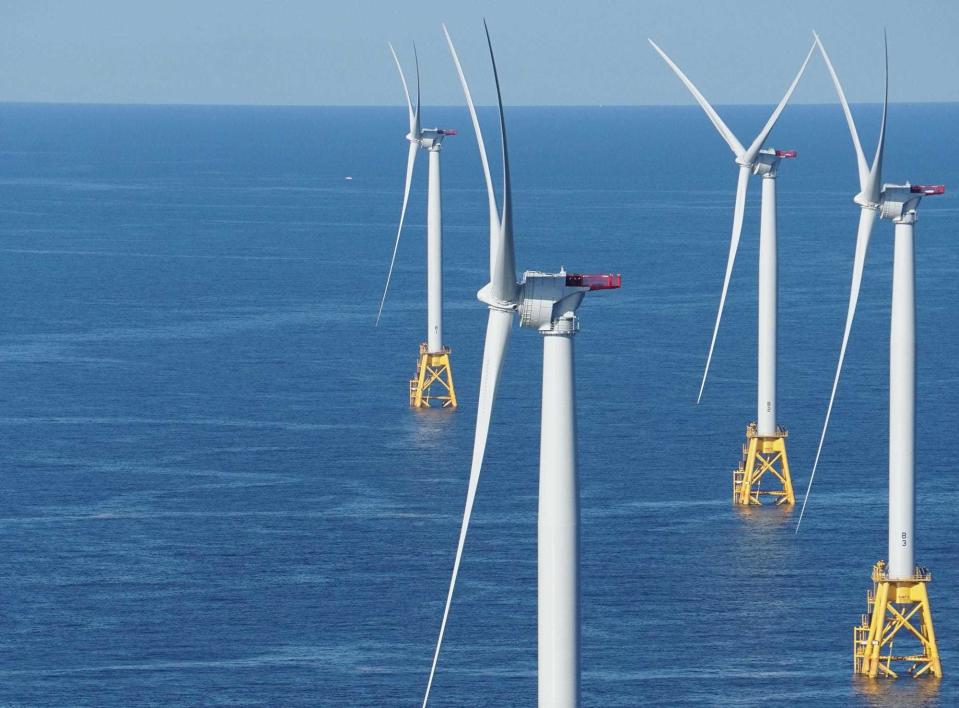NJ offshore wind industry threatened by economic uncertainty, 2024 presidential election
Renewable energy companies are bracing for higher costs and more lawsuits, experts say, which will likely make 2024 another difficult year for the offshore wind industry in New Jersey.
The industry is also threatened by the prospect of a change in the White House in the 2024 election. Industry leaders worry a new president could slow progress on offshore wind farms for years.
Already the pressure has led some offshore wind developers to abandon or pause their projects, while other companies are cautiously moving forward.
Robots to help map the ocean
The tumult in the industry is not stopping Rutgers University professor Josh Kohut. An expert in ocean movements, he is moving ahead with plans to deploy autonomous underwater robots this year. The gliders will spend weeks mapping the ocean and its inhabitants off the Jersey Shore to provide greater insights into the possible impacts of this growing technology.
"Everything is really dynamic out there (in the Atlantic)," said Kohut. "Our research challenge is to try and understand how we can make decisions on deploying a static wind farm for 30 years in an environment that inherently moves."
The gliders will study the depths for microscopic phytoplankton and zooplankton, listening for the calls of marine mammals, recording fish varieties and taking temperatures, Kohut said.
Will the noise from underwater construction frighten off migrating marine mammals? Will the fields of wind turbines affect ocean currents? Will the ecosystem change as a result of the farms? Kohut's research aims to make finding clear answers more possible.
Could turbines be running in 3 years?
Just three years from now, the first wind turbines off New Jersey could be operational – at least if Atlantic Shores Offshore Wind meets construction timelines outlined in documents submitted to the federal Bureau of Ocean Energy Management. The company is envisioning that to be the first of its three large energy projects southeast of Long Beach Island.
Denmark-based Ørsted's Ocean Wind 1 and 2 projects would have been the first wind turbines off the Jersey Shore, but the company announced in October it would stop plans to build. The company has cited high inflation, expensive interest rates and supply chain bottlenecks as reason for the change of plans.
In a similar blow to the industry, BP and Equinor announced this month that they were halting plans to build Empire Wind 2, a project east of Long Branch and south of Long Island, in order to "reset" in the face of "changed economic circumstances."
The announcements bring into question whether the United States can meet its offshore wind timelines. President Joe Biden's administration had set a goal of 30 gigawatts of offshore wind in production around the nation by 2030, an investment the administration said would provide tens of thousands of jobs in the carbon-free energy sector as well as in industries that support those workers.

Yet a study by the National Renewable Energy Laboratory found that the U.S. supply chain of offshore wind manufacturing facilities, vessels, ports and workforce were still too limited to meet the nation's 2030 objectives.
Those challenges and economic pressures are not likely to let up in 2024, said Kris Ohleth, executive director of the Special Initiative on Offshore Wind, an organization that offers objective and science-based guidance to offshore wind developers and stakeholders.
"We are kind of right-sizing the projects and right-sizing the economics for a sustainable future of offshore wind," Ohleth said. "People think the sky is falling, when actually… this is kind of what needs to happen in the offshore wind journey. It doesn't mean offshore wind's over."
New Jersey pushes forward on offshore wind
Despite turbulence in the offshore wind market, New Jersey officials are working to forge ahead with offshore wind development. During his State of the State address this month, Murphy said: "This is not just about doing what is right for our planet. This is also about creating a generation of good-paying jobs in the industries that will – literally – power our future, like offshore wind and solar."
New Jersey is in the crosshairs of climate change. Rising seas combined with the Earth's crust sinking under the Garden State, a process called glacial isostatic adjustment, is causing sea level to rise faster along the Jersey Shore than in much of the rest of the world, according to Rutgers University.
In addition, climatologists and scientists say climate change is leading to more drenching storms, and thus more flooding, across New Jersey. Over the past 50 years, scientists say storms that caused extreme rainfall across the Garden State increased by 71%, according to the 2020 New Jersey Scientific Report on Climate Change.
Kohut, the Rutgers researcher who is studying the ocean in and around future turbine sites, pointed to other changes off the Jersey Shore.
"We're definitely seeing that the ocean temperatures have warmed off the coast of New Jersey" since the mid-1900s, he said.

In addition, the ocean is less salty than in decades past, likely due to a combination of Artic ice melting and more rainfall across New Jersey, Kohut said.
In the future, researchers will have to parse the ocean changes resulting from climate change from those caused by the wind farms.
"We need to understand and put the wind farm effects in that context," Kohut said. "I don't have the data yet to be able to say… 'Yeah, I predict it's going to be a big effect or a little effect.' But the factors that affect the ocean out there are significant and they cause the ocean to change all the time."
Searching for alternatives
As the oceans and atmosphere transform, New Jersey leaders are looking to offshore wind as a way to reduce reliance on fossil fuels. But that is no easy task. Currently, 73% of homes in the state rely on natural gas for heat, while another 9% use petroleum products like heating oil, according to the U.S. Energy Information Administration.
Even homes that rely solely on electricity contribute to greenhouse gas emissions; nearly half of New Jersey's electricity is generated by burning natural gas, according to the agency.
Gov. Murphy said offshore wind – despite economic headwinds – remains an important part of New Jersey's carbon-free energy future.
In October, the governor said: "We’ve seen a historically high number of bids into New Jersey’s ongoing third offshore wind solicitation, and the Board of Public Utilities will shortly announce two additional solicitations related to our first-in-the-nation State Agreement Approach to build an offshore wind transmission infrastructure."
Atlantic Shores Offshore Wind is in the process of obtaining permits to install power cables across the ocean floor between its first project site and Atlantic City. Construction of a maintenance and operations facility at the Atlantic City landfall site is also underway, according to a company spokesperson.
Atlantic Shores aims to build two projects off Atlantic City and Long Beach Island that will power about 1.3 million New Jersey homes when complete, the company told the Press earlier this month in an email. The company is waiting for a decision from the state Board of Public Utilities on its second project and is developing plans for a third project farther out to sea, in an area known as the New York Bight.
"Over the last five years our team has completed over 40+ environmental assessments ensuring we are delivering safe, reliable, and environmentally responsible renewable power," an Atlantic Shores spokesperson said in an email. "We are excited to continue our work in 2024 and beyond and remain committed to leading the establishment of a thriving domestic offshore wind industry anchored in New Jersey."
Challenges to offshore wind remain
High interest rates and manufacturing hiccups are not the only problems facing the offshore wind industry in 2024. The industry is facing an onslaught of lawsuits from offshore wind critics.
For instance, the organization Save Long Beach Island has sued the U.S. Department of Interior and the federal Bureau of Ocean Energy Management, or BOEM, over offshore wind projects and challenged the state Board of Public Utilities' renewable energy certificates award to Atlantic Shores.
Various municipalities have also sued the New Jersey Department of Environmental Protection, saying the agency was too biased from pressure from the governor's office to review offshore wind's environmental impacts.
Cape May County officials also announced a lawsuit against BOEM and the National Oceanic and Atmospheric Administration, or NOAA, to overturn agency approvals of Ørsted's first New Jersey project just days before the developer announced a halt to its projects.
"I would guess there'll be additional lawsuits in the region," said Ohleth, of the Special Initiative on Offshore Wind.
The 2024 president election is another possible threat to offshore developers, Ohleth said.
"We'll have a change in the White House by the end of this year, potentially," she said.
A Republican in the White House – Republicans have typically been more critical of the offshore wind industry – could put a hold on project movement, Ohleth said.
Related: 'No credible evidence' that offshore wind activity is killing whales, state officials say
Former President Donald Trump, who is leading so far in his re-election bid in the Republican primaries, is also no friend to offshore wind energy. Trump has blamed offshore wind turbines for whale deaths, while NOAA has said there is no scientific evidence linking offshore wind survey noise — the only offshore wind-related activity so far happening off New Jersey — with whale deaths. Rather, many whale deaths are the result of vessel strikes or entanglement with fishing gear, according to NOAA.
"In the offshore wind industry, there's this subtext right now of 'This could be the last year for a while of real progress in offshore wind,' if this shift (in the White House) happens," Ohleth said. "How do we create a durable offshore wind sector that can…outlive political terms? Because it's just not healthy, frankly, for any type of infrastructure development to be going through these swings."
Amanda Oglesby is an Ocean County native who covers education and the environment. She has worked for the Press for more than a decade. Reach her at @OglesbyAPP, aoglesby@gannettnj.com or 732-557-5701.
This article originally appeared on Asbury Park Press: Will NJ offshore wind survive economic uncertainty, election?

